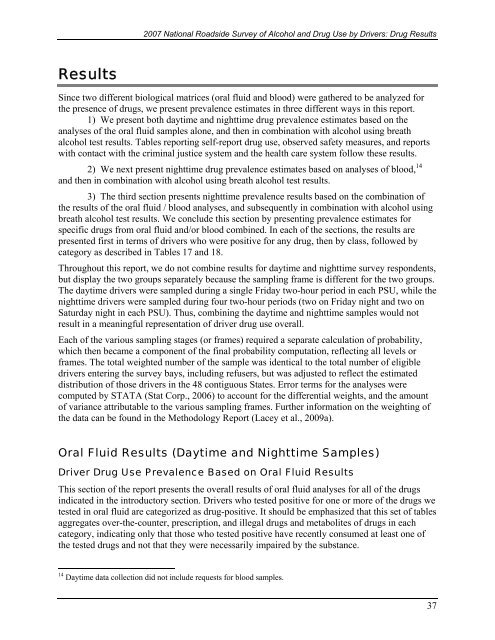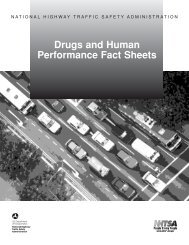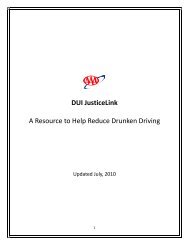2007 National Roadside Survey of Alcohol and Drug Use by Drivers
2007 National Roadside Survey of Alcohol and Drug Use by Drivers
2007 National Roadside Survey of Alcohol and Drug Use by Drivers
Create successful ePaper yourself
Turn your PDF publications into a flip-book with our unique Google optimized e-Paper software.
<strong>2007</strong> <strong>National</strong> <strong>Roadside</strong> <strong>Survey</strong> <strong>of</strong> <strong>Alcohol</strong> <strong>and</strong> <strong>Drug</strong> <strong>Use</strong> <strong>by</strong> <strong>Drivers</strong>: <strong>Drug</strong> ResultsResultsSince two different biological matrices (oral fluid <strong>and</strong> blood) were gathered to be analyzed forthe presence <strong>of</strong> drugs, we present prevalence estimates in three different ways in this report.1) We present both daytime <strong>and</strong> nighttime drug prevalence estimates based on theanalyses <strong>of</strong> the oral fluid samples alone, <strong>and</strong> then in combination with alcohol using breathalcohol test results. Tables reporting self-report drug use, observed safety measures, <strong>and</strong> reportswith contact with the criminal justice system <strong>and</strong> the health care system follow these results.2) We next present nighttime drug prevalence estimates based on analyses <strong>of</strong> blood, 14<strong>and</strong> then in combination with alcohol using breath alcohol test results.3) The third section presents nighttime prevalence results based on the combination <strong>of</strong>the results <strong>of</strong> the oral fluid / blood analyses, <strong>and</strong> subsequently in combination with alcohol usingbreath alcohol test results. We conclude this section <strong>by</strong> presenting prevalence estimates forspecific drugs from oral fluid <strong>and</strong>/or blood combined. In each <strong>of</strong> the sections, the results arepresented first in terms <strong>of</strong> drivers who were positive for any drug, then <strong>by</strong> class, followed <strong>by</strong>category as described in Tables 17 <strong>and</strong> 18.Throughout this report, we do not combine results for daytime <strong>and</strong> nighttime survey respondents,but display the two groups separately because the sampling frame is different for the two groups.The daytime drivers were sampled during a single Friday two-hour period in each PSU, while thenighttime drivers were sampled during four two-hour periods (two on Friday night <strong>and</strong> two onSaturday night in each PSU). Thus, combining the daytime <strong>and</strong> nighttime samples would notresult in a meaningful representation <strong>of</strong> driver drug use overall.Each <strong>of</strong> the various sampling stages (or frames) required a separate calculation <strong>of</strong> probability,which then became a component <strong>of</strong> the final probability computation, reflecting all levels orframes. The total weighted number <strong>of</strong> the sample was identical to the total number <strong>of</strong> eligibledrivers entering the survey bays, including refusers, but was adjusted to reflect the estimateddistribution <strong>of</strong> those drivers in the 48 contiguous States. Error terms for the analyses werecomputed <strong>by</strong> STATA (Stat Corp., 2006) to account for the differential weights, <strong>and</strong> the amount<strong>of</strong> variance attributable to the various sampling frames. Further information on the weighting <strong>of</strong>the data can be found in the Methodology Report (Lacey et al., 2009a).Oral Fluid Results (Daytime <strong>and</strong> Nighttime Samples)Driver <strong>Drug</strong> <strong>Use</strong> Prevalence Based on Oral Fluid ResultsThis section <strong>of</strong> the report presents the overall results <strong>of</strong> oral fluid analyses for all <strong>of</strong> the drugsindicated in the introductory section. <strong>Drivers</strong> who tested positive for one or more <strong>of</strong> the drugs wetested in oral fluid are categorized as drug-positive. It should be emphasized that this set <strong>of</strong> tablesaggregates over-the-counter, prescription, <strong>and</strong> illegal drugs <strong>and</strong> metabolites <strong>of</strong> drugs in eachcategory, indicating only that those who tested positive have recently consumed at least one <strong>of</strong>the tested drugs <strong>and</strong> not that they were necessarily impaired <strong>by</strong> the substance.14 Daytime data collection did not include requests for blood samples.37




